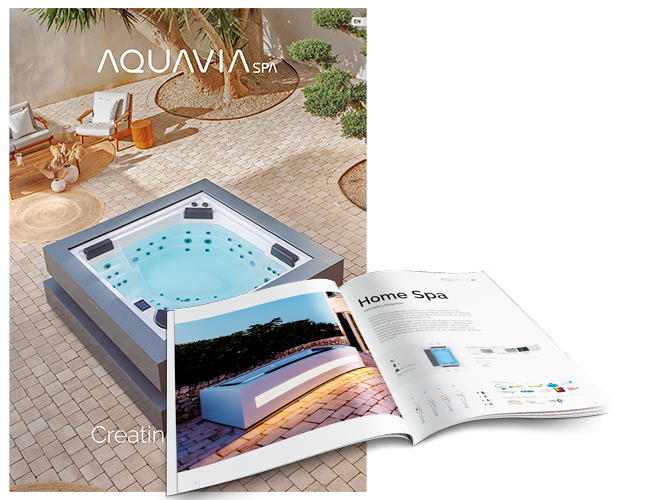One of the biggest concerns when buying a hot tub, is how much the hot tub / swimspa will cost and how it will impact my home’s energy bill. There are several elements that we can configure when buying a hot tub / swimspa, such as the insulation (Ecospa or Nordic Insulation system), the cover (included in all our standard hot tubs/ swimspas), the consumption of the pumps (the more pumps, the more electricity consumption) and, of course, the consumption of the hot tub’s heating system. This last point is the one we are going to study in this article; we will assess how a heat pump can affect your energy consumption and how we can take advantage of this new technology in hot tubs/ swimspas.
I want a heat pump for my hot tub or swimspa!
Installing a heat pump in your hot tub / swimspa can provide several benefits, among them:
- Constant temperature: A pump can maintain the temperature of your hot tub / swimspa water constantly, allowing you to enjoy your hot tub / swimspa at any time, without worrying about changes in air temperature.
- Energy savings: Compared to other hot tub / swimspa heating systems, pumps are very energy efficient, which can help reduce your energy bill in the long run.
- Convenience: A pump can heat hot tub / swimspa water quickly, which means you won’t have to wait long to enjoy your hot tub / swimspa.
- Durability: Heat pumps are designed to last for many years and are able to withstand a wide range of weather conditions.
- Low maintenance: In general, pumps require little maintenance, which means that you can enjoy your hot tub / swimspa without having to worry about their operation.

To sum up, installing a heat pump in your hot tub / swimspa can provide a more comfortable, efficient and economical experience.
When will I save by installing a heat pump in my hot tub/ swimspa?
The amount of energy savings that can be obtained by using a heat pump compared to a 3 kW electric heater to heat the water in a hot tub / swimspa will depend on several factors, such as the efficiency of the pump, the ambient temperature and the frequency of use of the hot tub.
However, in general, it is estimated that a pump can save between 50% and 70% energy compared to a 3 kW electric heater. This is because a pump uses energy from the outside air to heat the hot tub / swimspa water, whereas an electric heater converts electrical energy directly into heat.
It is important to note that the initial investment in installing a heat pump may be higher than that of an electric resistance heater, but in the long run, the savings in energy costs can offset this cost difference. In addition, a pump may have a longer lifetime and require less maintenance than an electric resistance, which can provide additional savings in the long run.

To calculate the euro savings that can be obtained by using a pump versus an electric heating element to warm up hot tub / swimspa water, several factors must be considered, such as the cost of electrical energy, the efficiency of the pump, the ambient temperature and the frequency of hot tub / swimspa use.
Below is a general formula that can be used to calculate the savings in Euros:
Savings in euros = (Energy consumed by the electrical resistance – Energy consumed by the heat pump) x Price of electrical energy.
So how can I save by installing a heat pump in my hot tub / swimspa?
The secret of heat pumps is the COP (Coefficient of Performance), which is defined as the ratio between the amount of heat the heat pump is capable of supplying and the amount of energy required to supply that heat.
The pump incorporated in our Aquavia Spas has a COP of:

This means that, for example, at a 10°C ambient temperature, for every 1.1 kW consumed, the heat pump delivers between 4.45 and 4.83 kW, whereas with an electric resistance, we would always be consuming and delivering 3 kW.
This factor reduces the water heating time in the hot tub / swimspa and, consequently, the energy cost of maintaining the water at 36.5°C, which is the temperature we recommend as the manufacturer for enjoying a hydrotherapy bath.
What else should you know?
There are several factors you should consider:
- Our heat pump is fully integrated with the control panel, allowing you to conveniently control it from your hot tub / swimspa.
- The Aquavia Spa pump can heat or cool the hot tub / swimspa water.
- The maximum power of the heat pump is 5 kW.
- The average energy savings with the pump range from 50% to 70%, depending on external conditions and hot tub / swimspa insulation.
- Our hot tubs / swimspas with heat pumps always have an electric resistance that activates in case of very low temperatures.
- If you want to install a pump in your existing hot tub / swimspa, contact your installer (it requires certain changes in hydraulics and electronic components).
- Maintaining the heat pump is simple, but in general, it is recommended to have a qualified technician inspect and maintain the heat pump at least once a year to ensure safe and efficient operation.
Conclusions
Choose this option for your new Aquavia Spa is an ideal choice if you are looking for energy savings. It is an efficient system compared to the traditional electric resistance, allowing you to save on hot tub / swimspa maintenance costs. Combined with appropriate insulation options, you will achieve daily savings in your hot tub / swimspa.


